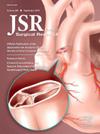心脏手术后并发症导致住院时间离散增加:29,544例分析
IF 1.7
3区 医学
Q2 SURGERY
引用次数: 0
摘要
心脏手术后并发症延长住院时间(LOS)。然而,每种并发症对LOS的个体影响作为一个连续变量尚未被研究。本研究的目的是确定心脏手术后个体术后并发症与风险调整后的LOS增加相关。方法对2005-2018年美国外科医师学会国家外科质量改进计划参与者使用档案中所有仅行冠状动脉旁路移植术(CABG)、CABG +瓣膜和仅行瓣膜的患者进行评估。采用负二项模型调整术前特征和18个术后并发症的影响,得出发病率比。该模型用于估计每种并发症的风险调整后的LOS增加。结果29544例患者中,单纯CABG 18184例(61.6%),单纯瓣膜8304例(28.1%),CABG +瓣膜3056例(10.3%),平均LOS为6.9 d。最常见的并发症是出血需要输血(49.2%)、延长通气(6.0%)和肺炎(4.1%)。感染并发症,包括深部手术部位感染(+18.9 d)、术后感染性休克(+17.2 d)、器官间隙感染(+16.7)和伤口裂开(+15.9),与LOS增加最多相关,其次是呼吸系统并发症,包括计划外再插管(+12.5)和延长通气(+10.9)。出血或术后输血(+0.6)对延长LOS的影响最小。结论在对术前患者特征和其他术后并发症进行风险调整后,除心肌梗死外,所有心脏手术后并发症均与延长的LOS相关,从出血需要输血的+0.6 d到深部手术部位感染的+18.9 d不等。本研究的结果为质量改进举措提供了有用的证据,并告知患者和提供者心脏手术后有或无并发症的预期住院时间。本文章由计算机程序翻译,如有差异,请以英文原文为准。
Discrete Increases in Length of Stay by Complication After Cardiac Surgery: Analysis of 29,544 Cases
Introduction
Postcardiac surgery complications prolong length of stay (LOS). However, each complication's individual impact on LOS as a continuous variable has not been studied. The purpose of this study was to determine the risk-adjusted increase in LOS associated with individual postoperative complications following cardiac surgery.
Methods
All coronary artery bypass and grafting (CABG)-only, CABG + valve, and valve-only patients in the American College of Surgeons National Surgical Quality Improvement Program participant use file, 2005-2018 were evaluated. A negative-binomial model adjusting for the effect of preoperative characteristics and 18 postoperative complications was used to generate incidence rate ratios. This model was used to estimate risk-adjusted increases in LOS for each complication.
Results
Of 29,544 patients, 18,184 (61.6%) were CABG only, 8304 (28.1%) were valve only, and 3056 (10.3%) were CABG + valve, with a median LOS of 6.9 d. The most frequent complications were bleeding requiring transfusion (49.2%), prolonged ventilation (6.0%), and pneumonia (4.1%). Infectious complications, including deep surgical site infection (+18.9 d), postoperative septic shock (+17.2 d), organ space infection (+16.7), and wound dehiscence (+15.9), were associated with the largest increases in LOS, followed by respiratory complications, including unplanned reintubation (+12.5) and prolonged ventilation (+10.9). Bleeding or postoperative transfusion (+0.6) had the least effect on extending LOS.
Conclusions
After risk adjustment for preoperative patient characteristics and other postoperative complications, all postcardiac surgery complications except myocardial infarction were associated with prolonged LOS, ranging from +0.6 d with bleeding requiring transfusion to +18.9 d with deep surgical site infection. The results of this study provide useful evidence for quality improvement initiatives and informing patients and providers on the expected duration of hospital stay following cardiac surgery with and without complications.
求助全文
通过发布文献求助,成功后即可免费获取论文全文。
去求助
来源期刊
CiteScore
3.90
自引率
4.50%
发文量
627
审稿时长
138 days
期刊介绍:
The Journal of Surgical Research: Clinical and Laboratory Investigation publishes original articles concerned with clinical and laboratory investigations relevant to surgical practice and teaching. The journal emphasizes reports of clinical investigations or fundamental research bearing directly on surgical management that will be of general interest to a broad range of surgeons and surgical researchers. The articles presented need not have been the products of surgeons or of surgical laboratories.
The Journal of Surgical Research also features review articles and special articles relating to educational, research, or social issues of interest to the academic surgical community.

 求助内容:
求助内容: 应助结果提醒方式:
应助结果提醒方式:


